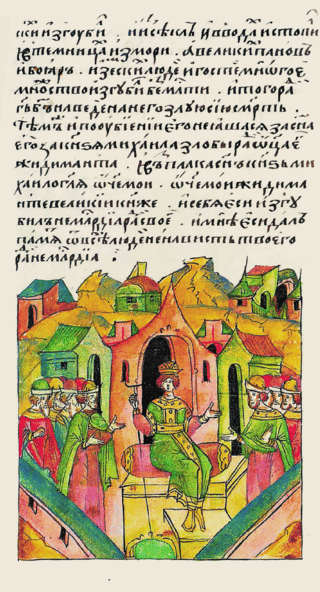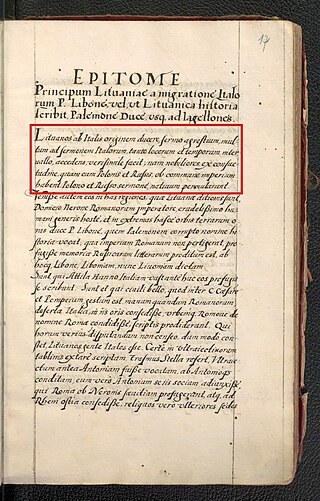
The Grand Duchy of Lithuania was a sovereign state in northeastern Europe that existed from the 13th century, succeeding the Kingdom of Lithuania, to the late 18th century, when the territory was suppressed during the 1795 partitions of Poland–Lithuania. The state was founded by Lithuanians, who were at the time a polytheistic nation of several united Baltic tribes from Aukštaitija, which by 1440, became the largest European state controlling an area from the Baltic Sea in the north to the Black Sea in the south.

The Lithuanian nobility or Lithuanian szlachta was historically a legally privileged hereditary elite class in the Kingdom of Lithuania and Grand Duchy of Lithuania consisting of Lithuanians from Lithuania Proper; Samogitians from Duchy of Samogitia; following Lithuania's eastward expansion into what is now Belarus, Ukraine and Russia, many ethnically Ruthenian noble families (boyars); and, later on, predominantly Baltic German families from the Duchy of Livonia and Inflanty Voivodeship. It traced its origins via Palemonids to Polemon II of Pontus.

The coat of arms of Lithuania is a mounted armoured knight holding a sword and shield, known as Vytis. Since the early 15th century, it has been Lithuania's official coat of arms and is one of the oldest European coats of arms. It is also known by other names in various languages, such as Waykimas, Pagaunė in the Lithuanian language or as Pogonia, Pogoń, Пагоня in the Polish, and Belarusian languages. Vytis is translatable as Chase, Pursuer, Knight or Horseman, similar to the Slavic vityaz. Historically – raitas senovės karžygys or in heraldry – raitas valdovas.

Švitrigaila was the Grand Duke of Lithuania from 1430 to 1432. He spent most of his life in largely unsuccessful dynastic struggles against his cousins Vytautas and Sigismund Kęstutaitis.

The Columns of Gediminas or Pillars of Gediminas are one of the earliest symbols of Lithuania and its historical coats of arms. They were used in the Grand Duchy of Lithuania, initially as a rulers' personal insignia, a state symbol, and later as a part of heraldic signs of leading aristocracy.

The Union of Grodno was a series of acts of the Polish–Lithuanian union between Kingdom of Poland and Grand Duchy of Lithuania. The first acts were signed in 1432 during the Lithuanian Civil War of 1431–1435. The acts confirmed the Union of Vilnius and Radom (1401). The Union established Sigismund Kęstutaitis as the Grand Duke of Lithuania and re-established Władysław II Jagiełło's seniority and dynastic interest in Lithuania.

Michael Žygimantaitis was pretender to the throne of the Grand Duchy of Lithuania and the last male descendant of Kęstutis, Grand Duke of Lithuania.
Jaunė was daughter of Prince Ivan of Polatsk and wife of Gediminas, the Grand Duke of Lithuania (1316–1341). She is mentioned in written sources only once – the Bychowiec Chronicle, a late and unreliable source. Therefore, some historians cast a serious doubt on her existence, but modern reference works still widely cite her as the ancestress of the Gediminids dynasty.

The Palemonids were a legendary dynasty of Grand Dukes of the Grand Duchy of Lithuania. The legend was born in the 15th or 16th century as proof that Lithuanians and the Grand Duchy are of Roman origins. Already Jan Długosz (1415–1480) wrote that the Lithuanians were of Roman origin, but did not provide any proof. The legend is first recorded in the second edition of the Lithuanian Chronicle produced in the 1530s. At the time the Grand Duchy of Lithuania was quarrelling with the Kingdom of Poland, rejecting the claims that Poland had civilized the pagan and barbaric Lithuania. The Lithuanian nobility felt a need for the ruling dynasty to show upstanding origins, as the only available chronicles at the time were written by the Teutonic Knights, a long-standing enemy, and depicted Gediminas, ancestor of the Gediminids dynasty, as a hostler of Vytenis.

Jonas Gostautas or Goštautas was a Lithuanian nobleman from the Grand Duchy of Lithuania of the Gasztołd (Goštautai) noble family, a politician and skillful land owner. He served as Chancellor of Lithuania between 1443 and 1458 and was a very close advisor and mentor to Casimir IV Jagiellon before he became the third Jagiellonian King of Poland. Gostautas was not his surname, but a pagan Lithuanian given name retained after baptism by his immediate ancestor, while Jonas was his Christian name. His heirs, e.g., his sons like Martynas Goštautas, perhaps inherited the name as a surname. In 1413 at the Union of Horodło, Jonas was adopted by the Polish nobles into the Abdank clan.

Jogaila, later Władysław II Jagiełło (ca.1351/1361–1434), was a Grand Duke of Lithuania and from 1386 King Jadwiga's husband and jure uxoris King of Poland. In Lithuania, he held the title Didysis Kunigaikštis, translated as Grand Duke or Grand Prince.
The Lithuanian Council of Lords was the main permanent institution of central government in the Grand Duchy of Lithuania active in its capital city of Vilnius.

The family of Gediminas is a group of family members of Gediminas, Grand Duke of Lithuania, who interacted in the 14th century. The family included the siblings, children, and grandchildren of the Grand Duke and played the pivotal role in the history of Lithuania for the period as the Lithuanian nobility had not yet acquired its influence. Gediminas was also the forefather of the Gediminid dynasty, which ruled the Grand Duchy of Lithuania from 1310s or 1280s to 1572.

The Duchy of Lithuania was a state-territorial formation of ethnic Lithuanians that existed from the 13th century to 1413. For most of its existence, it was a constituent part and a nucleus of the Grand Duchy of Lithuania. Other alternative names of the territorial formation, used in different periods, were Aukštaitija or Land of Lithuania, Duchy of Vilnius, Lithuania proper, or simply Lithuania.
The Lithuanian Chronicles are three redactions of chronicles compiled in the Grand Duchy of Lithuania. All redactions were written in the Ruthenian language and served the needs of Lithuanian patriotism. The first edition, compiled in the 1420s, glorified Vytautas the Great and supported his side in power struggles. The second redaction, prepared in the first half of the 16th century, started the myth of Lithuanian Roman origin: it gave a fanciful genealogy of Palemon, a noble from the Roman Empire who founded the Grand Duchy. This noble origin of Lithuanians was important in cultural rivalry with the Kingdom of Poland. The third redaction, known as the Bychowiec Chronicle, elaborated even further on the legend, but also provided some useful information about the second half of the 15th century. The three redactions, the first known historical accounts produced within the Grand Duchy, gave rise to the historiography of Lithuania. All medieval historians used these accounts, that survived in over 30 known manuscripts, as basis for their publications and some of the myths created in the chronicles persisted even to the beginning of the 20th century.

The family of Kęstutis, Grand Duke of Lithuania (1381–1382), is listed here. He co-ruled with his brother Algirdas from 1345 to 1377.

The Jagiellonian or Jagellonian dynasty, otherwise the Jagiellon dynasty, the House of Jagiellon, or simply the Jagiellons, was the name assumed by a cadet branch of the Lithuanian ducal dynasty of Gediminids upon reception by Jogaila, the Grand Duke of Lithuania, of baptism as Władysław in 1386, which paved the way to his ensuing marriage to the Queen Regnant Jadwiga of Poland, resulting in his ascension to the Crown of the Kingdom of Poland as Władysław II Jagiełło, and the effective promotion of his branch to a royal dynasty. The Jagiellons reigned in several European countries between the 14th and 16th centuries. Members of the dynasty were Kings of Poland (1386–1572), Grand Dukes of Lithuania, Kings of Hungary, and Kings of Bohemia and imperial electors (1471–1526).

Gediminas' Cap was the most important regalia of the Lithuanian monarchs who ruled the Grand Duchy of Lithuania until the Union of Lublin in 1569. During the inaugurations of Lithuanian monarchs, Gediminas' Cap was placed on the monarch's heads by the Bishop of Vilnius in Vilnius Cathedral.















